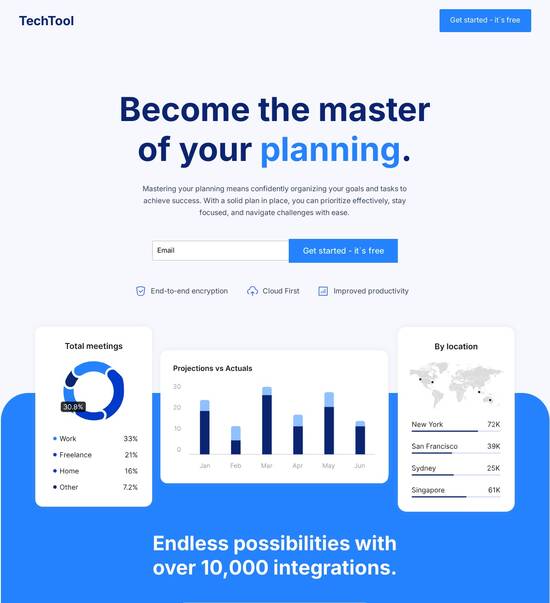
Onboarding page template for supply chain teams
Explore Similar TemplatesAbout template
Just pick the right onboarding page template for supply chain teams and customize it on the spot. See more to streamline your marketing performance.
Recommended templates

Easy to build without coding
With the intuitive drag-and-drop builder, anyone on your team can create high-converting pages without any knowledge of code or design. Make enhancements to your landing page with custom widgets using Javascript, HTML/CSS, or third-party scripts.

Multiple layouts for any industry and goal
Select from 500+ landing page layouts built to boost conversions across industry-specific scenarios. Customize them by adjusting fonts, adding images, and generating on-brand content with the AI assistant. Quickly scale with Instablocks® and Global Blocks that you can save, reuse, and update globally.

Loads fast and looks polished on any device
Every template is responsive, which means they present professionally on any device and load blazingly fast with our Thor Render Engine. You can also power them up with Google AMP technology to deliver an unparalleled mobile experience and drive higher conversions.

Robust analytics & experimentation
Get real-time updates and reporting across all your devices, showing the number of visitors, conversions, cost-per-visitor, and cost-per-lead. Launch AI-powered experiments, run A/B tests, and use heatmaps to analyze user behavior, then optimize your landing page to maximize conversions.







Easy to build without coding
With the intuitive drag-and-drop builder, anyone on your team can create high-converting pages without any knowledge of code or design. Make enhancements to your landing page with custom widgets using Javascript, HTML/CSS, or third-party scripts.
Multiple layouts for any industry and goal
Select from 500+ landing page layouts built to boost conversions across industry-specific scenarios. Customize them by adjusting fonts, adding images, and generating on-brand content with the AI assistant. Quickly scale with Instablocks® and Global Blocks that you can save, reuse, and update globally.
Loads fast and looks polished on any device
Every template is responsive, which means they present professionally on any device and load blazingly fast with our Thor Render Engine.
Robust analytics & experimentation
Get real-time updates and reporting across all your devices, showing the number of visitors, conversions, cost-per-visitor, and cost-per-lead. Launch AI-powered experiments, run A/B tests, and use heatmaps to analyze user behavior, then optimize your landing page to maximize conversions.
All the features you need to build lead-generating landing pages
Explore more featuresLearn how to build top-performing landing pages for any goal
FAQs
Leading the way in building high-performing landing pages





An effective onboarding page template for supply chain teams
In the fast-paced world of supply chain management, having a comprehensive onboarding page template is essential for seamless team integration. Instapage's powerful landing page tools empower teams to create tailored templates that elevate onboarding experiences and significantly enhance operational efficiency.
Importance of a dedicated onboarding page
A streamlined onboarding process is crucial for supply chain teams as it ensures that new members quickly grasp essential systems and protocols. A dedicated onboarding page centralizes resources, providing clarity and focus that enables new hires to hit the ground running. Here's why organizations should invest in effective onboarding:
- Improves retention: A well-structured onboarding reduces turnover by ensuring that new employees feel welcomed and supported.
- Enhances productivity: Clear guidelines and necessary resources allow newcomers to grasp their roles faster, leading to immediate contributions.
- Builds team cohesion: Establishing shared goals and values from the start promotes unity and collaboration among team members.
Step 1: Design your onboarding page
Designing your onboarding page with Instapage is achievable thanks to its user-friendly interface and multitude of design templates. Start by identifying essential elements that will contribute to a positive experience for new team members:
- Choose the right template: Select a layout that aligns with your brand and is optimized for conversions.
- Add personalization features: Incorporate dynamic text replacement to tailor experiences to individual users.
- Utilize multimedia elements: Videos and infographics can help explain complex processes more engagingly.
Step 2: Integrate essential resources
An effective onboarding page should curate essential resources that equip new hires with necessary information. This integration can include documents, videos, and interactive content:
- Quick access to training materials: Link to manuals, training guides, and onboarding schedules that provide clarity on roles and expectations.
- Contact points for support: Offer direct lines to supervisors or mentors who can assist with questions or guidance.
- Feedback mechanisms: Enable newcomers to share their onboarding experiences to continually improve the process.
Step 3: Optimize for user engagement
Optimization is fundamental for ensuring that the onboarding page resonates well with its audience. Utilize A/B testing and analytics to refine the page's impact:
- Conduct A/B tests: Experiment with different layouts and calls to action to see which variations yield better engagement.
- Analyze user feedback: Gather insights from new hires to understand their onboarding experience and adjust accordingly.
- Regular updates: Refresh content and resources based on organizational changes or new systems.
In conclusion, creating an effective onboarding page using Instapage is a straightforward process that can significantly benefit supply chain teams. By focusing on design, resource integration, and optimization, organizations can ensure that their new employees are well-prepared and engaged from day one.
Ready to streamline your onboarding process? Sign up for Instapage today, and take the first step towards an empowered supply chain team!
People also ask about Onboarding page template for supply chain teams
Onboarding page template for supply chain teams
Understanding the importance of onboarding in supply chain management
Onboarding is a critical process that sets the stage for new employees in supply chain teams. It encompasses a variety of activities aimed at integrating newcomers into the organization’s culture and familiarizing them with operational protocols and expectations. Proper onboarding ensures that employees feel welcomed and are equipped to contribute effectively to team goals from the onset.
An effective onboarding process enhances team efficiency and cohesion. When new hires understand their roles and how they fit into the larger supply chain framework, they can collaborate better with their peers, leading to improved productivity. Furthermore, a structured onboarding approach helps prevent misunderstandings that can hinder operations.
Improves retention rates by helping new hires feel valued and informed.
Enhances productivity by allowing employees to reach their peak performance more quickly.
Strengthens team morale and reduces onboarding anxiety.
Conversely, ineffective onboarding can lead to significant drawbacks. New employees may feel disoriented and unsupported, potentially resulting in high turnover rates. Miscommunication stemming from a lack of proper orientation can disrupt supply chain activities, leading to delays and inefficiencies. Highlighting real-world scenarios where poor onboarding has led to operational disruptions can solidify the importance of implementing a robust onboarding page template.
Key elements of an effective onboarding page template
An effective onboarding page should prioritize user experience in its design. This includes creating an interface that is easy to navigate, allowing new employees to quickly locate relevant materials. A responsive design is essential, as users will access the onboarding page from various devices—such as mobile phones, tablets, or desktop computers—each requiring an optimal viewing experience.
Moreover, a well-structured information architecture can significantly enhance the onboarding process. Essential components like a welcome message, an overview of the company, and detailed insight into supply chain operations and team structures (such as organizational charts) should be easily accessible. Utilizing flowcharts can offer a visual representation of onboarding processes, allowing newcomers to grasp their journey through training and integration.
Welcoming introduction and company profile overview.
Detailed descriptions of supply chain operations and team structure.
Access to training resources, such as video tutorials and reading materials.
Including initial training resources is crucial, particularly in specialized fields like supply chain management. Providing presentations, tutorials, and additional resources directly on the onboarding page fosters a smoother transition into the team and informs new hires of the competencies required for their roles.
Enhancing communication and collaboration through the onboarding page
Communication and collaboration are paramount within supply chain teams, and the onboarding page can facilitate these elements. Integrating collaborative tools like Gantt charts can help depict project management timelines, making it easier for new employees to understand their tasks and how they contribute to overall objectives.
Additionally, having forms for feedback and queries embedded in the onboarding page encourages new hires to communicate their thoughts and concerns. This avenue not only fosters engagement but also ensures quick adjustments can be made to the onboarding process based on real-time feedback. At the same time, employees should have access to real-time data, such as dashboards that track key performance indicators and monitor individual progress in roles.
Incorporation of Gantt charts for visual project management.
Forms for immediate feedback and questions to enhance engagement.
Dashboards for tracking performance metrics and onboarding progress.
The accessibility of data is crucial for strategic decision-making within supply chain operations. Empowering new hires with the tools to view real-time data allows them to understand their impacts within the organization and aligns their objectives with those of the company.
Leveraging technology and automation in onboarding
In the modern workplace, technology plays a pivotal role in streamlining onboarding processes. Artificial intelligence can be particularly beneficial by providing personalized learning paths that adapt to the individual needs of new hires. For example, AI-powered training modules can address varied experience levels, ensuring that each employee's onboarding experience is tailored to their skill set.
Furthermore, incorporating cybersecurity education as part of onboarding is essential. Given the increasing threats to digital infrastructures, new employees must be trained in awareness and risk management processes to protect organizational assets effectively. Automation tools can also simplify the onboarding process by streamlining document submissions, approvals, and scheduling follow-ups, leading to a more efficient integration experience.
AI-driven personalized training experiences and learning paths.
Integration of cybersecurity training in onboarding protocols.
Automation of documentation and onboarding schedules.
By leveraging automation, organizations can free up time for HR and team leaders, allowing them to focus on developing the culture around onboarding and engagement rather than on mundane administrative tasks.
Customizing the onboarding experience for different categories
Recognizing that supply chain teams encompass a range of roles is critical to shaping an effective onboarding experience. Customizing onboarding materials for diverse job functions within the supply chain is necessary to ensure that each employee receives the specific knowledge and tools relevant to their position. For instance, the requirements for logistics coordinators differ significantly from those of finance analysts.
Furthermore, businesses operate under various models which also dictate the onboarding framework. Startups typically necessitate a more adaptable onboarding process that grows with the company, whereas established businesses might require a more structured approach that adheres to pre-defined protocols. Adjusting onboarding experiences according to digital transformation initiatives can foster an environment that is better suited for current market demands.
Role-specific onboarding materials for greater relevance.
Tailored onboarding strategies based on business models (startups vs. established firms).
Adaptation of onboarding experiences in line with digital transformation efforts.
By creating customized onboarding content, organizations can foster engagement from the very start, instilling a sense of belonging and relevance which can lead to enhanced job satisfaction.
Preparing new employees with management and strategy tools
An effective onboarding process should also equip new hires with the management best practices that are essential in the supply chain environment. Understanding the intricacies involved in budgeting, resource allocation, and project management is fundamental. These foundational skills can empower employees to make informed decisions early in their tenure.
Report generation is another area of focus during onboarding. New employees should be trained on how to create reports that track onboarding effectiveness and overall employee performance. This not only encourages accountability but also helps them contribute valuable insights to the team. Familiarizing new hires with actual business cases informs them about practical applications of their roles within the company’s marketing and operational strategies.
Training on management best practices for budget and resource allocation.
Guidance on creating reports for tracking onboarding success and performance.
Engagement with business cases for practical understanding of supply chain relevance.
Equipping new employees with strategic tools from the beginning helps them relate to the bigger picture of the organization and their specific contributions.
Promoting engagement and continuous learning
Engagement during onboarding is a multi-faceted effort combining multiple elements to keep new hires interested and involved. Instilling a culture of feedback is vital; acknowledgment within the onboarding process can make a world of difference in how new recruits perceive their roles. Collecting data on their experiences and insights enables organizations to adapt the onboarding process and improve overall satisfaction.
Incorporating ongoing education resources into the onboarding page is essential for fostering a culture of continuous learning. Providing links to online courses, certifications, and additional training materials allows employees to further develop their skills, reflecting the organization’s commitment to their professional growth. Creating a resource library can also serve as an invaluable tool for ongoing professional development.
Encouraging feedback throughout the onboarding experience to enhance the process.
Links to online courses and certifications fostering continuous education.
A centralized resource library for employee professional development.
Establishing an environment that promotes continuous learning not only helps employees grow but also aids in talent retention, as individuals feel valued and supported through ongoing development opportunities.
Effective measurement of onboarding outcomes
Measuring the effectiveness of onboarding is crucial for identifying success indicators and areas for improvement. Establishing key performance indicators (KPIs) specific to the onboarding process helps organizations gauge new employee integration and satisfaction. Metrics such as time to proficiency and employee engagement scores can offer insights into the overall effectiveness of the onboarding page and process.
Utilizing reports and analytics tools can significantly enhance the measurement of onboarding outcomes. Organizations can analyze onboarding data to uncover actionable insights that inform future improvements. For instance, identifying patterns in feedback and performance can lead to adjustments in training directives, ensuring employees receive the support and information they need to succeed. The integration of analytics dashboards can provide real-time adjustments to improve coaching and development resources.
Identifying relevant KPIs for tracking onboarding effectiveness.
Employing analytics tools to extract actionable insights from onboarding data.
Real-time assessments to fine-tune coaching and development programs.
Regularly reviewing these metrics allows organizations to adapt strategies and ensure their onboarding is fulfilling both organizational needs and the expectations of new hires.
Real-life implementation scenarios and case studies
Success stories can serve as powerful motivators for implementing an effective onboarding page template. Highlighting case studies from supply chain teams that have successfully curated their onboarding processes to improve operations is particularly impactful. For example, companies that implemented structured onboarding and introduced mentoring programs saw a notable decrease in turnover rates and an increase in productivity.
Analyzing these success stories can also yield valuable lessons learned and best practices. By examining common challenges faced by supply chain teams, organizations can identify the roadblocks that hinder effective onboarding. Insights and strategies shared by industry consultants can provide guidance on optimizing the onboarding page template, contributing to better integration of new hires and higher operational efficiency.
Case studies showcasing enhanced operations through improved onboarding.
Challenges faced by supply chain teams and strategies to overcome them.
Expert insights and recommendations for optimizing onboarding processes.
Leveraging real-life scenarios not only inspires organizations to adopt effective strategies but also reinforces the value of a tailored onboarding page template.
Future trends in onboarding for supply chain teams
As workplace dynamics change, so too will onboarding practices, particularly with the rise of remote work. The need for virtual onboarding processes that can effectively build relationships and cultures among dispersed teams is becoming paramount. Organizations must adapt to these shifts, incorporating tools that provide connections and collaboration opportunities despite physical distances.
Innovations in digital tools and technologies will also play a significant role in the future of onboarding. Emerging technologies like virtual reality (VR) and augmented reality (AR) might enable immersive onboarding experiences. These technologies have the potential to transform how employees learn about company culture, logistics, and role expectations. Staying ahead of these trends will be essential for organizations committed to providing superior onboarding experiences.
Emphasis on developing remote onboarding strategies to adapt to new work environments.
Exploration of emerging technologies to enhance immersive learning experiences.
Focused attention on maintaining team engagement and company culture in remote settings.
Organizations that keep pace with these evolving trends will not only enhance their onboarding processes but also ensure they attract and retain top talent in an increasingly competitive landscape.
Ready to skyrocket conversions?
Supercharge your ad campaigns with high-performing landing pages
Get started














